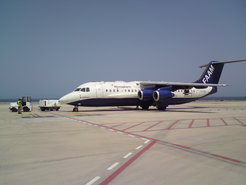FENNEC - The Saharan climate system

Fuerteventura, June 2011
The aim of FENNEC was to quantify and model boundary layer and aerosol processes over the Saharan 'heat low' region, the greatest dust region during summer. The project included an aircraft field campaign with the FAAM BAe-146.
The climate of the Saharan region is unique and characterized by:
- The summertime Saharan heat-low (SHL) system, having a uniquely deep boundary layer (BL) structure.
- The world’s largest mineral dust aerosol loadings.
Specific project goals were:
- Better observations of the Saharan atmosphere
- Improve understanding of processes.
- Improve understanding of model deficiencies.
The British research aircraft BAe-146 (operated by FAAM/Directflight) was stationed at Fuerteventura in June 2011 and conducted research flights over the Sahara. MPIC operated the ALABAMA single particle laser ablation mass spectrometer onboard the BAe. This was the second aircraft based deployment of ALABAMA. Unfortunately, due to numerous technical problems during the campaign we were not able to record data.
Coordination: The FENNEC - Saharan Climate System project is a NERC consortium project lead by the University of Oxford (Richard Washington) and involving the Universities of Leeds, Reading, Sussex and the Met Office.
Further information (and results) from the FENNEC project can be found here:
- UK NERC FENNEC website
- French FENNEC subproject Website
Instrumentation:
ALABAMA
People involved:
A. Roth, T. Klimach, T. Böttger, J. Schneider
